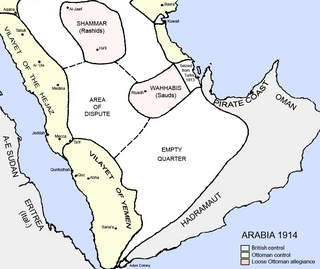
The history of Saudi Arabia in its current form as a state began with its foundation in 1744, although the human history of the region extends as far as 20,000 years ago. The region has had a global impact twice in world history:
- In the 7th century it became the cradle of Islam and the capital of the Islamic Rashidun Caliphate.
- From the mid-20th century the discovery of vast oil deposits propelled it into a key economic and geo-political role.

The Hejaz railway was a narrow-gauge railway that ran from Damascus to Medina, through the Hejaz region of Saudi Arabia, with a branch line to Haifa on the Mediterranean Sea. It was a part of the Ottoman railway network and the original goal was to extend the line from the Haydarpaşa Terminal in Kadikoy beyond Damascus to the holy city of Mecca. However, construction was interrupted due to the outbreak of World War I, and it reached no further than Medina, 400 kilometres (250 mi) short of Mecca. The completed Damascus to Medina section was 1,300 kilometres (810 mi).

Hussein ibn Ali al-Hashimi was a Hashemite Arab leader who was the Sharif and Emir of Mecca from 1908 and, after proclaiming the Arab Revolt against the Ottoman Empire, King of the Hejaz from 1916 to 1924. At the end of his reign he also briefly laid claim to the office of Caliph. He was said to be a 37th-generation direct descendant of Muhammad as he belongs to the Hashemite family.

The Arab Revolt or Great Arab Revolt was a military uprising of Arab forces against the Ottoman Empire in the Middle Eastern theatre of World War I. On the basis of the McMahon–Hussein Correspondence, an agreement between the British government and Hussein bin Ali, Sharif of Mecca, the revolt was officially initiated at Mecca on June 10, 1916. The aim of the revolt was the creation a single unified and independent Arab state stretching from Aleppo in Syria to Aden in Yemen, which the British had promised to recognize.

The Battle of Megiddo also known in Turkish as the Nablus Hezimeti, or the Nablus Yarması was fought between 19 and 25 September 1918, on the Plain of Sharon, in front of Tulkarm, Tabsor and Arara in the Judean Hills as well as on the Esdralon Plain at Nazareth, Afulah, Beisan, Jenin and Samakh. Its name, which has been described as "perhaps misleading" since very limited fighting took place near Tel Megiddo, was chosen by Allenby for its biblical and symbolic resonance.

The Hashemite Kingdom of Hejaz was a state in the Hejaz region in the Middle East, the western portion of the Arabian peninsula ruled by the Hashemite dynasty. It achieved national independence after the destruction of the Ottoman Empire by the British Empire, during World War I, when the Sharif of Mecca fought in alliance with the British Imperial forces to drive the Ottoman Army from the Arabian Peninsula during the Arab Revolt.

The Middle Eastern theatre of World War I saw action between 29 October 1914 and 30 October 1918. The combatants were, on one side, the Ottoman Empire, with some assistance from the other Central Powers; and on the other side, the British, the Russians and the French from among the Allied Powers. There were five main campaigns: the Sinai and Palestine Campaign, the Mesopotamian Campaign, the Caucasus Campaign, the Persian Campaign, and the Gallipoli Campaign. There were also several minor campaigns: the Senussi Campaign, Arab Campaign, and South Arabia Campaign.

The Battle of Aqaba was fought for the Red Sea port of Aqaba. The attacking forces of the Arab Revolt, led by Auda ibu Tayi and advised by T. E. Lawrence, were victorious over the Ottoman defenders.
Medina, an Islamic holy city in Arabia, underwent a long siege during World War I. Medina was at the time part of the Ottoman Empire. In the war, the Ottoman Empire sided with the Central Powers. Sharif Hussain of Mecca revolted against the caliph and the Ottoman Empire which, under the leadership of the nationalistic Young Turks, had ignored the wishes of the Caliph and sided with the Central Powers. Hussain instead sided with the British Empire. T. E. Lawrence was instrumental in this revolt. Hussain occupied Mecca and besieged Medina. It was one of the longest sieges in history that lasted till even after the end of war. Fahreddin Pasha was the defender of Medina. Some celebrated him as "the Lion of the Desert" despite the suffering of those who remained in Medina. The siege lasted two years and seven months.

The Battle of Mecca occurred in the Muslim holy city of Mecca in June and July 1916. On June 10, the Sharif of Mecca, Hussein bin Ali, the leader of the Banu Hashim clan, started a revolt against the Ottoman Caliphate from this city. The Battle of Mecca was part of the Arab Revolt of World War I.

The Sharifian Army, also known as the Arab Army or the Hejazi army was the military force behind the Arab Revolt which was a part of the Middle Eastern theatre of World War I. Sharif Husayn ibn 'Ali of the Kingdom of Hejaz, who was proclaimed "Sultan of the Arabs" in 1916, led the Sharifian Army in a rebellion against the Ottoman Empire with the ultimate goal of uniting the Arab people under an independent government. Aided both financially and militarily by the British, Husayn's forces gradually moved north through the Hijaz and, fought alongside the British-controlled Egyptian Expeditionary Force, eventually taking Damascus. Once there, members of the Sharifian Army set up a short-lived monarchy led by Faisal, a son of Sharif Husayn.

The Sharifate of Mecca Arabic: شرافة مكة Sharāfa Makka) or Emirate of Mecca was a state, non-sovereign for much of its existence, ruled by the Sharifs of Mecca. A sharif is a descendant of Hasan ibn Ali, Muhammad's grandson. In Western sources, the prince of Mecca was known as Grand Sherif, but Arabs have always used the appellation "Emir".

The Vilayet of the Hejaz refers to the Hejaz region of Arabia when it was administered as a first-level province (vilayet) of the Ottoman Empire. At the beginning of the 20th century, it reportedly had an area of 96,500 square miles (250,000 km2). The Hejaz included all land from the southern border of the Vilayet of Syria, south of the city of Ma‛an, to the northern border of the Vilayet of Yemen, north of the city of Al Lith.

This is the order of battle for the Battle of Megiddo (1918), the concluding engagement of the Sinai and Palestine Campaign of the First World War. The Entente's Egyptian Expeditionary Force, commanded by General Edmund Allenby and composed mainly of British, Indian, Australian and New Zealand troops, with a small French and Armenian contingent, cooperated with the Arab Northern Army, which was part of the Arab Revolt and was under the overall command of the Emir Feisal, in an all-out offensive against the Yıldırım Army Group, part of the army of the Ottoman Empire.
The battle of Yanbu was an Ottoman attempt to recapture the city of Yanbu.
The Battle of Wadi Musa was a battle fought between the Arab Army and the Ottoman Empire during the Arab Revolt of 1916–1918.

The Ottoman era in the history of Arabia lasted from 1517 to 1918. Ottoman degree of control over these lands varied over the four centuries with the fluctuating strength or weakness of the Empire's central authority.

Major Herbert Garland OBE, MC, FCS, M. Inst. Metals. was a British metallurgist and army officer. An Army Ordnance Corps member, in 1906 he was stationed on Guernsey, where he wrote a novel, Diverse Affections: a Romance of Guernsey. Garland rose to become Superintendent of Laboratories at the Cairo Citadel, Egypt by 1913 and received a grant from the Chemical Society, of which he was a fellow, to conduct research into ancient Egyptian alloys. The outbreak of war saw him commissioned as a Special List officer with the Arab Bureau. Garland developed explosives for the army, including the Garland grenade and was, in September 1916, assigned to train T. E. Lawrence and the fighters of the Arab Revolt in explosives. His mines were used against the Hejaz Railway and may have been involved in the first derailing of a moving train by explosives. Garland commanded the desperate defence of Yanbu in which he forced an attacking superior Ottoman force to withdraw with almost no bloodshed. Awarded the Military Cross and appointed an Officer of the Order of the British Empire, Garland became director of the Arab Bureau after the war and was involved in the post-war negotiations for the future of Arabia. Returning from Egypt because of poor health, Garland died within days of setting foot in England.
Robert Vere Buxton, known as Robin Buxton, was an English cricketer, soldier and banker.















